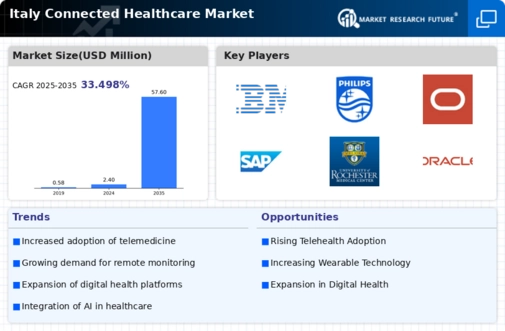Government Initiatives and Funding
Government initiatives and funding play a crucial role in shaping the connected healthcare market. In Italy, the government has launched various programs aimed at promoting digital health solutions, including telemedicine and electronic health records. These initiatives are supported by substantial investments, with the Italian Ministry of Health allocating approximately €200 million for digital health projects in the current fiscal year. Such funding is intended to enhance healthcare accessibility and efficiency, particularly in rural areas. The connected healthcare market benefits from these efforts, as they facilitate the integration of innovative technologies into existing healthcare systems. This alignment between government policy and market needs is likely to accelerate the adoption of connected healthcare solutions across the country.
Increased Focus on Health Data Security
The emphasis on health data security is becoming increasingly critical in the connected healthcare market. With the rise of digital health solutions, concerns regarding data privacy and security have escalated. In Italy, regulatory frameworks are being strengthened to protect patient information, with the implementation of the General Data Protection Regulation (GDPR) having a profound impact on how healthcare data is managed. Healthcare providers are investing in robust cybersecurity measures to safeguard sensitive information, which is essential for maintaining patient trust. This focus on data security is likely to drive the adoption of connected healthcare solutions, as patients become more aware of their rights and the importance of data protection. Consequently, the connected healthcare market is adapting to these challenges, ensuring that security measures are integrated into the development of new technologies.
Technological Advancements in Healthcare
Technological advancements are driving transformation within the connected healthcare market. Innovations such as artificial intelligence, machine learning, and advanced data analytics are enhancing the capabilities of healthcare providers. In Italy, these technologies are being integrated into various healthcare applications, from diagnostic tools to patient management systems. The market is witnessing a surge in the adoption of AI-driven solutions, which are expected to grow by 30% in the next few years. These advancements not only improve operational efficiency but also enhance patient outcomes by enabling more accurate diagnoses and personalized treatment plans. As technology continues to evolve, the connected healthcare market is likely to experience further growth and innovation.
Rising Demand for Remote Patient Monitoring
The increasing demand for remote patient monitoring is a pivotal driver in the connected healthcare market. In Italy, healthcare providers are increasingly adopting technologies that allow for continuous monitoring of patients' health metrics from their homes. This trend is driven by the need to manage chronic diseases effectively and reduce hospital readmissions. According to recent data, the remote patient monitoring segment is projected to grow at a CAGR of 25% over the next five years. This growth is indicative of a broader shift towards patient-centric care models, where healthcare professionals leverage connected devices to enhance patient engagement and outcomes. The connected healthcare market is thus evolving to meet these demands, ensuring that patients receive timely interventions and personalized care.
Aging Population and Chronic Disease Management
The aging population in Italy is a significant driver of the connected healthcare market. As the demographic landscape shifts, there is an increasing prevalence of chronic diseases such as diabetes and cardiovascular conditions. This demographic trend necessitates innovative healthcare solutions that can effectively manage these conditions. It is estimated that by 2030, over 25% of the Italian population will be over 65 years old, leading to a heightened demand for connected healthcare services. The market is responding by developing technologies that enable better disease management and patient monitoring. Consequently, the connected healthcare market is poised to expand as healthcare providers seek to implement solutions that cater to the needs of an aging population.





















Leave a Comment